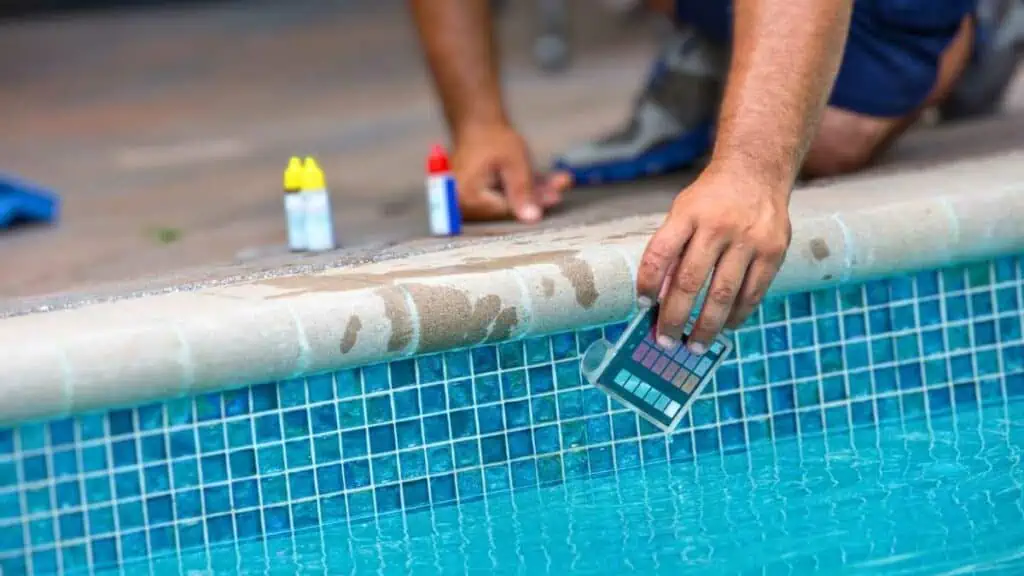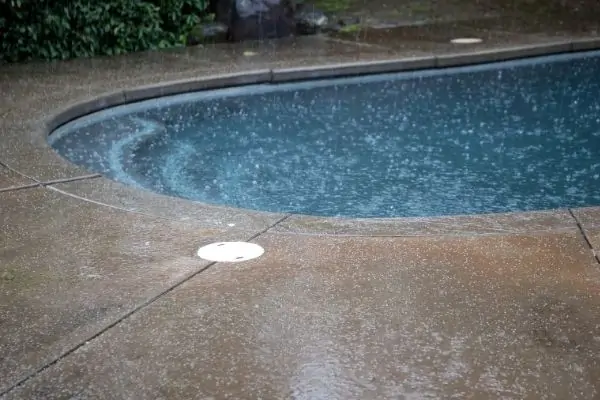Are you wondering how often you should test your pool water to keep it clean and safe? Regular pool water testing is necessary, but the frequency can vary based on several factors, such as usage and environmental conditions. Here’s a comprehensive guide to help you establish an effective pool testing routine. Well, we’ll be going over:
- What are the essential parameters to test in your pool water, and how often should you check them?
- How do different seasons and weather conditions affect your pool water testing frequency?
- What are some special considerations for maintaining different types of pools, like saltwater pools, and how does this affect testing schedules?
Maintaining the perfect balance in your pool is crucial for ensuring a safe and enjoyable swimming experience.

Key Takeaways
To maintain a clean and safe pool, test your water weekly, increasing to 2-3 times weekly during warmer, high-use months. The monitoring parameters include pH, chlorine/bromine levels, total alkalinity, and calcium hardness. Post-storm and heavy usage may require additional testing.
Pool Water Testing Frequency
Keeping your pool water clean and safe requires regular testing.
The exact frequency will vary depending on use and conditions, but a few general guidelines can help you set a routine.
Routine Water Testing
Consistency in testing is key to maintaining a healthy pool environment. You should test your pool water at least once a week.
However, during the warmer months, when pools are used more frequently, and the water can be influenced by a higher swimmer load, increasing temperatures, and more sunlight, it’s advisable to check the levels more often. Aim for 2-3 times a week to ensure that all chemical levels are within safe and comfortable parameters.
Testing is essential for measuring parameters like pH, chlorine or bromine levels, total alkalinity, and calcium hardness.
Keep a close eye on pH and check your chlorine levels (especially free chlorine) —the core indicators of your water’s health—by testing them at least twice weekly.
If you use too much chlorine or have a bromine pool, adjust your testing frequency to maintain a balanced water chemistry.
Each pool has its unique factors, such as size, filtration system, and exposure to elements, which can influence how often you should test. As a new pool owner, testing 2-3 times weekly is beneficial until you are familiar with the natural fluctuations of your specific pool. Use this period to learn the ropes of basic pool maintenance.
Quick Testing Frequency Checklist:
- Weekly Testing: At least once, regardless of weather or use.
- Peak Summer Testing: Increase to 2-3 times weekly due to higher temperatures and use.
- Post Storm: Test after heavy rain or windstorms, as these can introduce contaminants.
- Heavy Usage: Additional testing between regular schedules is wise if your pool is subject to frequent use.
- Adjust for Chemicals: More frequent chlorine usage requires more frequent testing.

Pool Test Kits and Methods
When maintaining your pool, the correct test kit is crucial for accurate water testing. This section guides you through choosing the right kit to ensure your pool’s water quality.
When selecting a test kit, consider the following factors:
- Range of Tests: Ensure the kit covers all the parameters you need to monitor.
- Ease of Use: Look for kits with clear instructions and simple procedures.
- Accuracy: Accuracy is essential for maintaining pool chemicals at safe levels.
- Cost: Balance your budget with the features and accuracy you require.
Your choice of pool test kit depends on the parameters you need to measure. Here are the main types of kits you’ll encounter:
Test Strips
These are the most user-friendly options. Dip a strip into your pool for a few seconds, and then match the resulting colors to the chart provided.
Test strips can measure various levels, including chlorine, pH, total alkalinity, and sometimes total dissolved solids (TDS).
Recommended Test Strips
Liquid Test Kits
Offering more precision, these kits involve adding a specified number of drops of a chemical reagent to a water sample. After a certain period, the color change will indicate the levels of specific components like chlorine and pH.
Recommended Test Kit
Digital Water Testers
Digital readers analyze test strips via an electronic device for a more high-tech approach and exact measurements. These can provide fast, detailed readings, including TDS levels not often covered by other test methods.
Recommended Digital Tester
TDS Meters
A TDS meter is specifically designed to measure total dissolved solids (TDS). This is important for overall water balance and can influence how effectively other pool chemicals work.
Key Water Parameters
Maintaining the right balance of key water parameters is essential for your pool’s health and safety. Regular testing will help ensure the water is ideal for swimming and prevent damage to the pool’s structure and systems.
pH and Alkalinity Levels
Your pool’s pH level measures how acidic or basic the water is. A balanced pH level is crucial for swimmer comfort and the effectiveness of other chemicals.
For optimal conditions, the pH level should be between 7.2 and 7.6. The total alkalinity, which should range from 80 to 120 ppm (parts per million), helps stabilize the pH and prevent it from fluctuating.
- Checklist for pH and Alkalinity:
- Test pH levels 2-3 times a week.
- Maintain pH within the 7.2-7.6 range.
- Adjust with alkaline substances if below 7.2.
- Correct total alkalinity to stabilize pH.
Chlorine and Sanitizer Levels
Chlorine is the most common sanitizer used to keep your pool water clean.
The free chlorine level, which indicates the amount of chlorine available to sanitize your pool, should typically be between 1.0 and 3.0 ppm.
Proper chlorine levels ensure harmful bacteria and algae are kept at bay.
If you use a stabilizer like cyanuric acid, which protects chlorine from sunlight, aim for 30 to 50 ppm to prevent chlorine degradation.
- Key Points for Sanitation:
- Free chlorine levels: Keep within 1.0-3.0 ppm.
- Test sanitizer levels twice per week.
- Use cyanuric acid to protect chlorine.
Calcium Hardness and Metals
Calcium hardness is the amount of dissolved calcium in the pool water and is an essential parameter to prevent plaster damage.
Ideal calcium hardness levels fall between 200 and 400 ppm. High levels can cause scale, whereas low levels can corrode pool fixtures.
Watch out for metals like iron and copper, which can stain your pool surfaces or discolor the water. Metal levels should ideally be at zero.
- Guidelines for Hardness and Metals:
- Maintain calcium hardness between 200-400 ppm.
- Remove metals using specific treatments if necessary.
- Test for calcium hardness monthly.
Special Pool Water Testing Considerations

When maintaining your pool, you should account for factors like weather and usage, which can significantly influence water chemistry. Here, you’ll learn how these elements can affect your pool and how to adjust your maintenance routine accordingly.
Weather Impact on Pool Water
Weather conditions have a direct impact on your pool’s water chemistry. For example:
- High temperatures can cause increased evaporation and sanitizer consumption, requiring you to test and adjust chemicals frequently.
- Rainfall can dilute sanitizer levels and introduce contaminants, so test your water after significant precipitation.
| Weather Condition | Action |
|---|---|
| High temperatures (>90ºF) | Test 2-3 times a week |
| Moderate temperatures (65-89ºF) | Test weekly |
| Cool temperatures (<65ºF) | Test every two weeks |
Pool Usage and Contamination
The more your pool is used, the more contaminants (like oils, sweat, and sunscreen) get introduced into the water. This affects the sanitizer levels:
- During heavy use (e.g., a pool party), test your water before and after the event.
- For new pool owners, consider testing 2-3 times a week until you are familiar with your pool’s needs.
Frequently Asked Questions
Regular swimming pool water testing is critical for pool care to ensure safety and enjoyment. Here are some of the most commonly asked questions to help maintain your pool’s health.
How often do you need to check the chemical levels in a swimming pool?
You should test for sanitizer levels and pH balance at least two to three times a week. For total alkalinity, it is recommended that you test once weekly, and calcium hardness, metals, and cyanuric acid levels should be tested monthly.
What’s the best frequency for testing chlorine and pH levels in my pool?
Chlorine and pH levels should be tested at least two to three times per week to maintain proper water chemistry and ensure swimmer comfort and safety.
Can you recommend how frequently to use test strips for maintaining pool water quality?
Test strips are a convenient way to check your pool water quality. For a general overview of your pool’s chemical balance, use them at least two to three times a week.
What should the testing schedule look like for saltwater pool maintenance?
For saltwater pools, check chlorine and pH levels two to three times per week and test salt levels as your pool manufacturer recommends, which can be around every month. Inspect the salt cell regularly for any buildup and clean it as necessary.
Is it necessary to test my pool water more often during the hot summer months?
Yes, the pool water is usually warmer during the summer months and experiences higher usage. This can alter chemical levels more quickly. You should test your pool water more often to maintain proper balance.








Leave a Reply